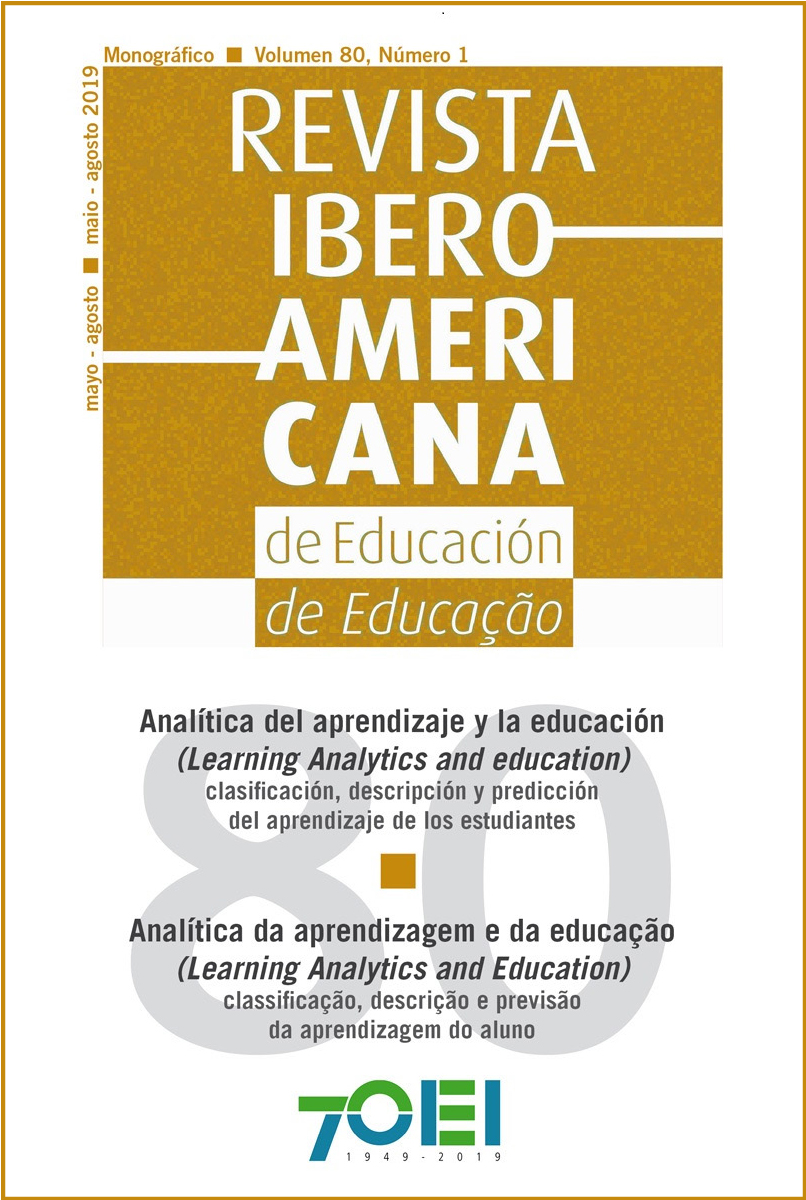Indicadores necessários para criar um dashboard na perspectiva dos professores: um estudo qualitativo
DOI:
https://doi.org/10.35362/rie8013462Palavras-chave:
learning analytics, dashboard, planejamento do curso, professor, processo de aprendizagem do aluno, autorregulaçãoResumo
O número de alunos matriculados em cursos de ensino superior on-line está aumentando e, como resultado, mais dados são gerados sobre seu processo de aprendizagem. Os dados gerados podem ser exibidos em um dashboard e ajudar os alunos em seu processo de aprendizagem. No entanto, a perspectiva dos professores deve ser levada em conta no momento da definição dos indicadores do dashboard, uma vez que o planejamento dos cursos poderia ter um impacto sobre os elementos nele incluídos. E este é precisamente o objetivo deste trabalho: definir os indicadores necessários para criar um dashboard para os estudantes de cursos on-line, considerando a perspectiva dos professores. Este estudo foi realizado com 10 professores da Faculdade de Humanidades e Educação de Mondragon Unibertsitatea. Foram utilizados questionários on-line qualitativos para coletar as percepções dos participantes. Os resultados mostram que a maioria dos professores que participaram da pesquisa identificou quatro indicadores para criar um dashboard para os alunos: número de vezes que os alunos acessam o fórum do curso, número de contribuições no fórum, número de vezes que os alunos consultam o guia do aluno do curso e o número de vezes que cada aluno acessou o curso em uma semana. As conclusões deste estudo destacam a importância da formação de professores e alunos no uso pedagógico da visualização de dados.
Downloads
Referências
Baker, B. M. (2007). A conceptual framework for making knowledge actionable through capital formation. University of Maryland University College.
Buckingham Shum, S., & Ferguson, R. (2012). Social learning analytics. Educational Technology & Society, 15(3), 3-26.
Corrin, L., & de Barba, P. (2015). How do students interpret feedback delivered via dashboard? Paper presented at the International Conference on Learning Analytics and Knowledge, Poughkeepsie, NY.
Dawson, S., Gasevic, D., Siemens, G., & Joksimovic, S. (2014). Current state and future trends: a citation network analysis of the learning analytics field. Paper presented at the International Conference on Learning Analytics and Knowledge, Indianapolis, IN.
Dawson, S., Bakharia, A., & Heathcote, E. (2010). SNAPP: Realising the affordances of real-time SNA within networked learning environments. Networked Learning-Seventh International Conference.
Dawson, S., Heathcote, E., & Poole, G. (2010). Harnessing ICT potential: The adoption and analysis of ICT systems for enhancing the student learning experience. International Journal of Educational Management, 24(2), 116-128.
Ferguson, R. (2012). The state of learning analytics in 2012: a review and future challenges (KMI-12-01). The Open University, UK.
Few, S. (2007). Dashboard confusion revisited. Perceptual Edge.
Gasevic, D., Dawson, S., & Siemens, G. (2015). Let´s not forget: learning analytics are about learning. TechTrends, 59, 64-75.
Goodyear, P. (2015). Teaching as design. HERDSA Review of Higher Education Vol. 2, (pp. 27-50).
Heathcote, E. (2006). Learning design templates-A pedagogical just-in-time support tool. In G. Minshull & J. Mole (Eds.), Designing for learning: The proceedings of Theme 1 of the JISC Online Conference: Innovating e-Learning (pp. 19-26).
Ipiña, N., Basagoiti, R., Jimenez, O., & Arriaran, I. (2016). Recommendations as a key aspect for online learning personalization: perceptions of teachers and students. International Scholarly and Scientific Research & Innovation 10(10) 3391-3395. doi:10.5281/zenodo.1127511
Krumm, A. E., Waddington, R. J., Teasley, S. D., & Lonn, S. (2014). A learning management system-based early warning system for academic advising in undergraduate engineering. In J. A. Larusson & B. White (Eds.), Learning analytics: from research to practice (pp. 103-119). New York: Springer Science+Business Media.
Leony, D., Pardo, A., de la Fuente Valentín, L., De Castro, D. S., & Kloos, C. D. (2012). GLASS: A learning analytics visualization tool. 2nd International Conference on Learning Analytics and Knowledge.
Lockyer, L., Heathcote, E., & Dawson, S. (2013). Informing pedagogical action: Aligning learning analytics with learning design. American Behavioral Scientist 57 (10) 1439-1459.
Means, B. (2014). Learning Online. What research tells us about whether, when and how. New York: Routledge.
Mor, Y., Ferguson, R., & Wasson, B. (2015). Editorial: Learning design, teacher inquiry into student learning and learning analytics: A Call for action. British Journal of Educational Technology, 46(2), 221-229.
Pardo, A., Jovanovic, J., Dawson, S., Gasevic, D., & Mirriahi, N. (2017). Using learning analytics to scale the provision of personalised feedback. British Journal of Educational Technology. doi: 10.1111/bjet.12592.
Rientes, B., Boroowa, A., Cross, S., Kubiak, C., Mayles, K., & Murphy, S. (2016). Analytics4Action evaluation framework: A review of evidence-based learning analytics interventions at the Open University UK. Journal of Interactive Media in Education, 1(2), 1-11. doi:10.5334/jime.394
Schwendimann, A., Rodriguez-Triana, M. J., Vozniuk, A., Prieto, L. P., Shirvani Boroujeni, M., Holzer, A., Gillet, D., Dillenbourg, P. (2016). Perceiving learning at a glance: A systematic literature review of learning dashboard research. IEEE Transactions on Learning Technologies 10(1), 1-1. doi:10.1109/TLT.2016.2599522
Steiner, C. M., Kickmeier-Rust, M. D., & Albert, D. (2014). Learning analytics and educational data mining: An overview of recent techniques. Learning analytics for and in serious games, pp. 6-15.
Sutherland, R., Eagle, S., & Jobert, M. (2012). A vision and strategy for Technology Enhanced Learning. STELLAR Network of Excellence.
Tanes, Z., Arnold, K. E., King, A. S., & Remnet, M. A. (2011). Using signals for appropiate feedback: perceptions and practices. Computers & Education, 57, 2414-2422. doi:10.1016/j.compedu.2011.05.016
Verbert, K., Govaerts, S., Duval, E., Santos, J.L., Assche, F., Parra, G., et al. (2014). Learning dashboards: an overview and future research opportunities. Personal and Ubiquitous Computing, 18 1499-1514. doi:10.1007/s00779-013-0751-2
Wise, A. F. (2014). Designing pedagogical interventions to support student use of learning analytics. Paper presented at the International Conference on Learning Analytics and Knowledge, New York, NY.
Yoo, Y., Lee, H., Jo, I. H., & Park, Y. (2015). Educational dashboards for smart learning: Review of case studies. Emerging Issues in Smart Learning. Springer, (pp. 145-155).
Como Citar
Downloads
Publicado
Edição
Seção
Licença
Os(as) autores(as) que publiquem nesta revista concordam com os seguintes termos:















